Denso

At Denso, we have painted our own picture of “future society” to encourage each of our employees to have clarity in his or her sense of mission. This will allow our staff to have conviction in their work, both planning and execution, which we consider crucial in our operation. Some say that if society continues in the same direction, the earth and humankind will be extinct. There is no way we can know this is true. However, we know for sure that we commonly share a wish to move towards the direction of sustainable prosperity without violence or poverty”. Now, at the turning-point that decides whether or not we can take this direction, Denso must be aware of these issues. Yet we also know that this is not something for Denso alone to do.
We wish to exchange ideas and initiatives, and share this mindset with TEDxTokyo 2013 participants and everyone who is interested in this movement. In this spirit, we would like to share here the questions we asked ourselves.
“Backcast” Perspective
In the current changeable environment surrounding enterprises, there is an urgent need to re-think our method of business planning and product development. So far, corporations’ R&D has depended on the “forecast” perspective that predicts the future environment by considering changes in trends and corporate law.
Further development of preexisting businesses and technologies are valued in “forecast” thinking – but we are seeing a limit to this in developing insights for change that takes place over the long-term.
Therefore, we think the “backcast” perspective should play a crucial role from now on – first speculating our society in the distant future, then identifying what needs to be done in the near future to adapt to the change.
As we imagine how future society will be, we are seeking to answer questions such as, “What is happiness in our lives?” or “What are the absolute necessities for us?”.
Watching out for the gap between forecast and backcast perspectives, we want to bring about innovations that will change our values for the better.
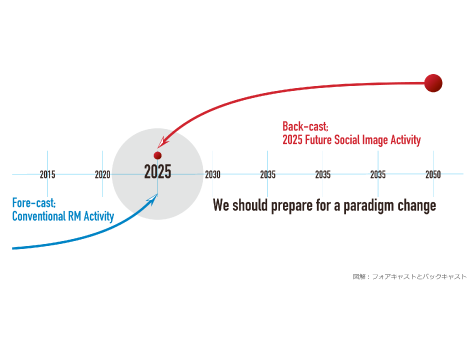
The State of Modern Society
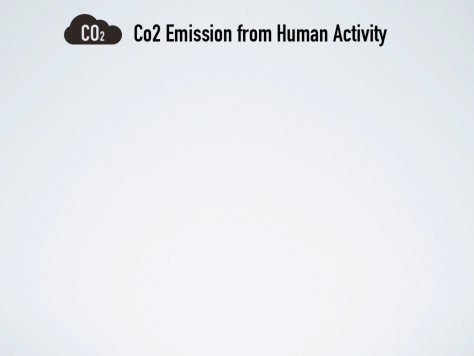

Co2 emission increase with population growth
World population is projected to reach 8 billion by 2025, and 9 billion by 2050.
As the population grows, energy consumption and gas exhaust will increase.
Take Co2 emission for an example: as of 2010, it is calculated to have already reached 2.5 times what the earth can absorb, and it is said to be unsustainable any longer.
Source: World Population Prospects
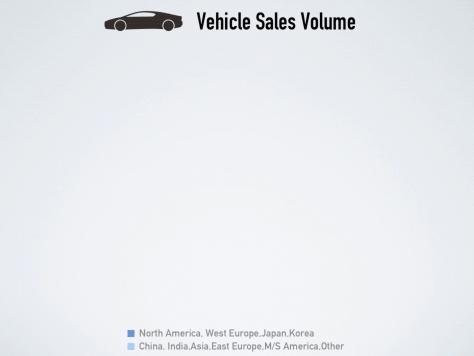

Car sales volume market change
The car market is seeing steady growth in North America, and stagnation in Europe and Japan. On the other hand, significant growth is expected in China, India, Asia and South America.
By 2025, car sales worldwide will reach 1 billion, twice the volume sold in 2010; meanwhile, car ownership is estimated to reach 1.5 billion, 1.5 times the level in 2010.
>Source: Denso Forecasts (2012)
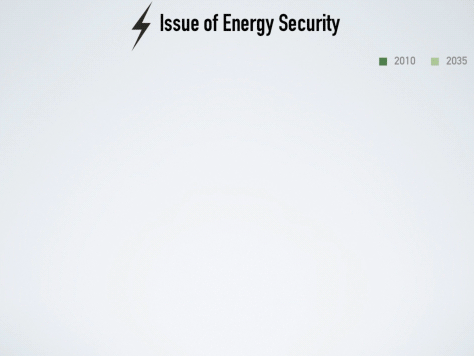

Car market energy issue
What with an increase in population as well as car demand, and changes in our target market, we need to think about society’s sustainability in 2025.
In terms of energy issues, there is hardly any country that is 100% self-sufficient, and the degree of dependency on imported energy wildly varies from country to country.
In the future, energy supply will see constraints, especially in China and India, and ASEAN countries – eventually we will have no choice other than to shift to renewable energy globally.
In short, we must live on the premise that by 2025, we will have less supply of existing energy, and then renew our concept of life and society.
Source:IEA World energy outlook 2011
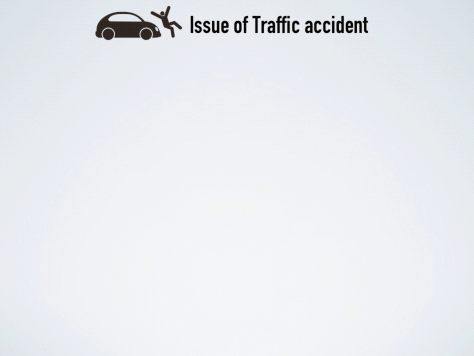

Toll of traffic accidents as population and car ownership increase
The rise in population and car ownership will play a role in increasing the rate of traffic accidents and fatalities.
Developing countries, where car ownership has been dramatically increasing, are already experiencing this trend. In 2020, the number of deaths by traffic accident will reach two million per year.
This is sadly comparable to a wartime death rate, which demands us to rethink the very purpose of vehicles.
We aim to create safer vehicles and establish a traffic-safe society, where car acts to protect us from danger, rather than being a threat.
Source: World Health Organization
2025 Lifestyle
In the future, Japan will have serious energy issues as well as an aging society with decreasing population. Here we depict “Our Lifestyle in 2025” to propose a course of action we can take now to prevent serious problems.
Lifestyle to overcome scarce energy/resources
Lifestyle to overcome hyper-aging society
with decreasing population
Environmental sustainability balanced with economic growth
Each member of society can live a happy and safe life

At Denso, we have painted our own picture of “future society” to encourage each of our employees to have clarity in his or her sense of mission. This will allow our staff to have conviction in their work, both planning and execution, which we consider crucial in our operation. Some say that if society continues in the same direction, the earth and humankind will be extinct. There is no way we can know this is true. However, we know for sure that we commonly share a wish to move towards the direction of sustainable prosperity without violence or poverty”. Now, at the turning-point that decides whether or not we can take this direction, Denso must be aware of these issues. Yet we also know that this is not something for Denso alone to do.
We wish to exchange ideas and initiatives, and share this mindset with TEDxTokyo 2013 participants and everyone who is interested in this movement. In this spirit, we would like to share here the questions we asked ourselves.
“Backcast” Perspective
In the current changeable environment surrounding enterprises, there is an urgent need to re-think our method of business planning and product development. So far, corporations’ R&D has depended on the “forecast” perspective that predicts the future environment by considering changes in trends and corporate law.
Further development of preexisting businesses and technologies are valued in “forecast” thinking – but we are seeing a limit to this in developing insights for change that takes place over the long-term.
Therefore, we think the “backcast” perspective should play a crucial role from now on – first speculating our society in the distant future, then identifying what needs to be done in the near future to adapt to the change.
As we imagine how future society will be, we are seeking to answer questions such as, “What is happiness in our lives?” or “What are the absolute necessities for us?”.
Watching out for the gap between forecast and backcast perspectives, we want to bring about innovations that will change our values for the better.

The State of Modern Society


Co2 emission increase with population growth
World population is projected to reach 8 billion by 2025, and 9 billion by 2050.
As the population grows, energy consumption and gas exhaust will increase.
Take Co2 emission for an example: as of 2010, it is calculated to have already reached 2.5 times what the earth can absorb, and it is said to be unsustainable any longer.
Source: World Population Prospects


Car sales volume market change
The car market is seeing steady growth in North America, and stagnation in Europe and Japan. On the other hand, significant growth is expected in China, India, Asia and South America.
By 2025, car sales worldwide will reach 1 billion, twice the volume sold in 2010; meanwhile, car ownership is estimated to reach 1.5 billion, 1.5 times the level in 2010.
>Source: Denso Forecasts (2012)


Car market energy issue
What with an increase in population as well as car demand, and changes in our target market, we need to think about society’s sustainability in 2025.
In terms of energy issues, there is hardly any country that is 100% self-sufficient, and the degree of dependency on imported energy wildly varies from country to country.
In the future, energy supply will see constraints, especially in China and India, and ASEAN countries – eventually we will have no choice other than to shift to renewable energy globally.
In short, we must live on the premise that by 2025, we will have less supply of existing energy, and then renew our concept of life and society.
Source:IEA World energy outlook 2011


Toll of traffic accidents as population and car ownership increase
The rise in population and car ownership will play a role in increasing the rate of traffic accidents and fatalities.
Developing countries, where car ownership has been dramatically increasing, are already experiencing this trend. In 2020, the number of deaths by traffic accident will reach two million per year.
This is sadly comparable to a wartime death rate, which demands us to rethink the very purpose of vehicles.
We aim to create safer vehicles and establish a traffic-safe society, where car acts to protect us from danger, rather than being a threat.
Source: World Health Organization
2025 Lifestyle
with decreasing population
